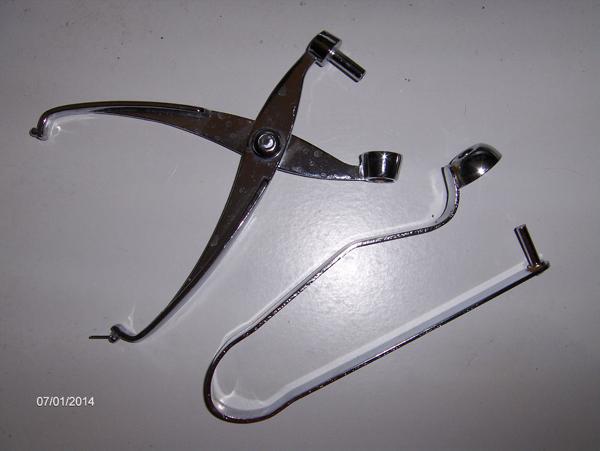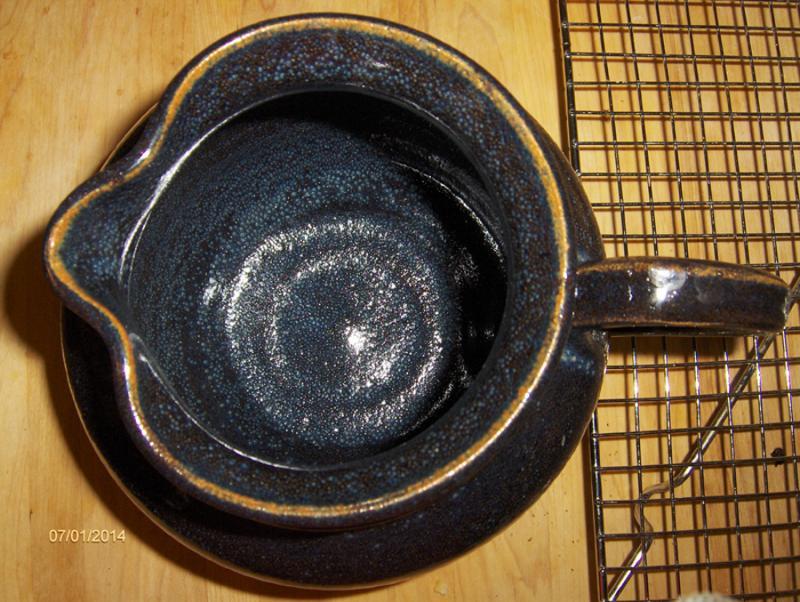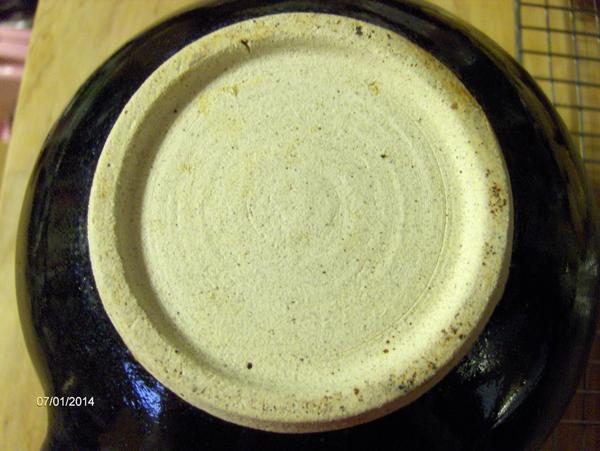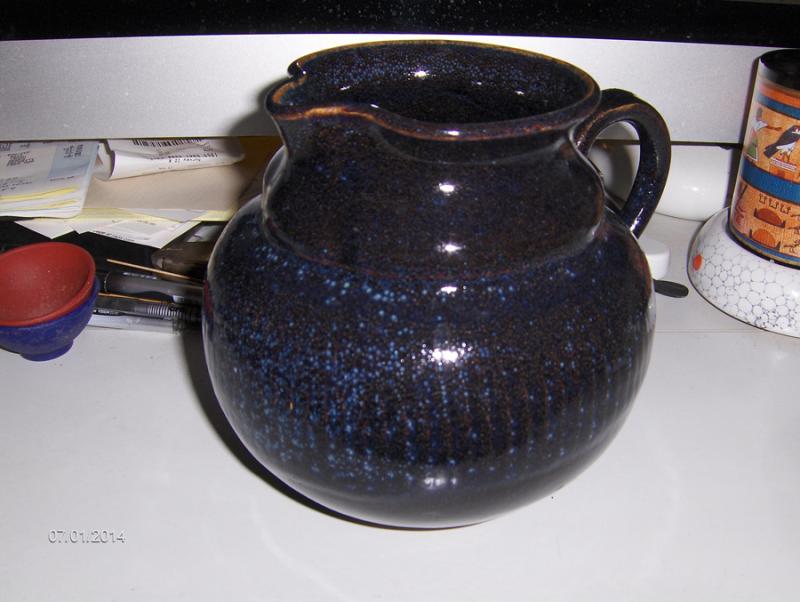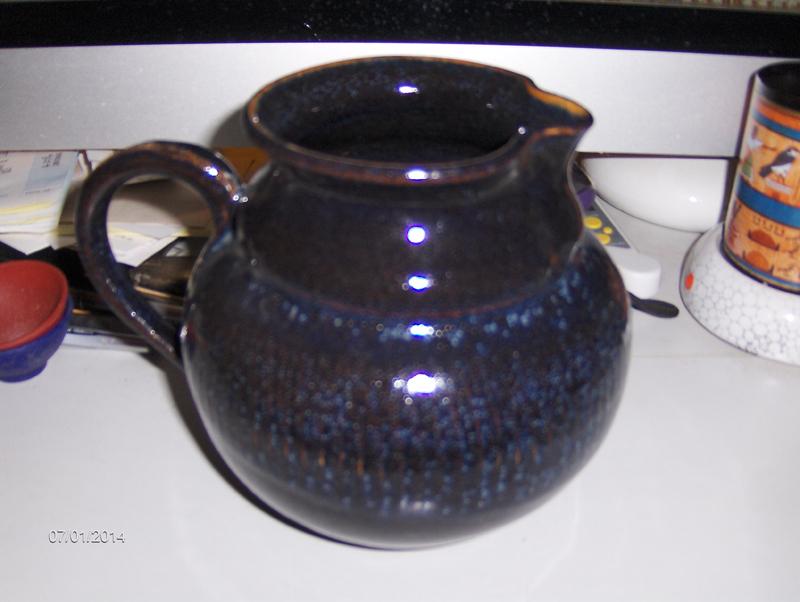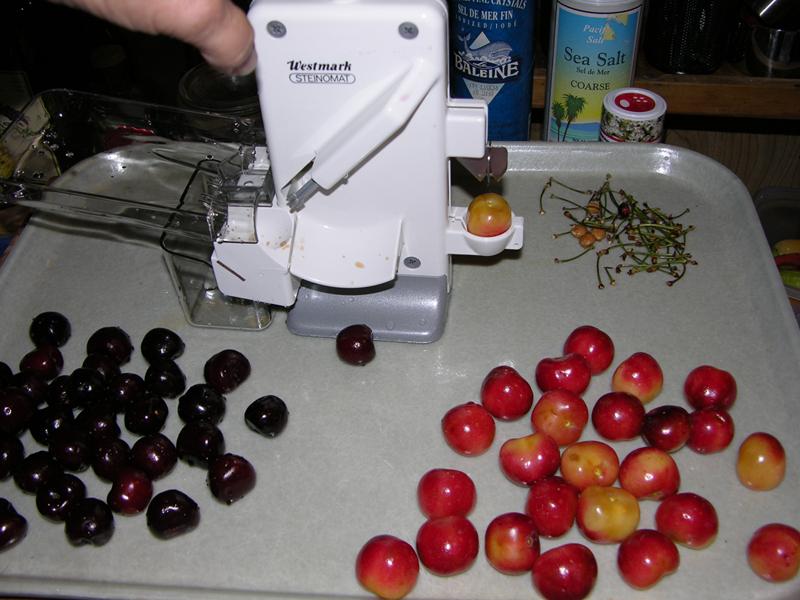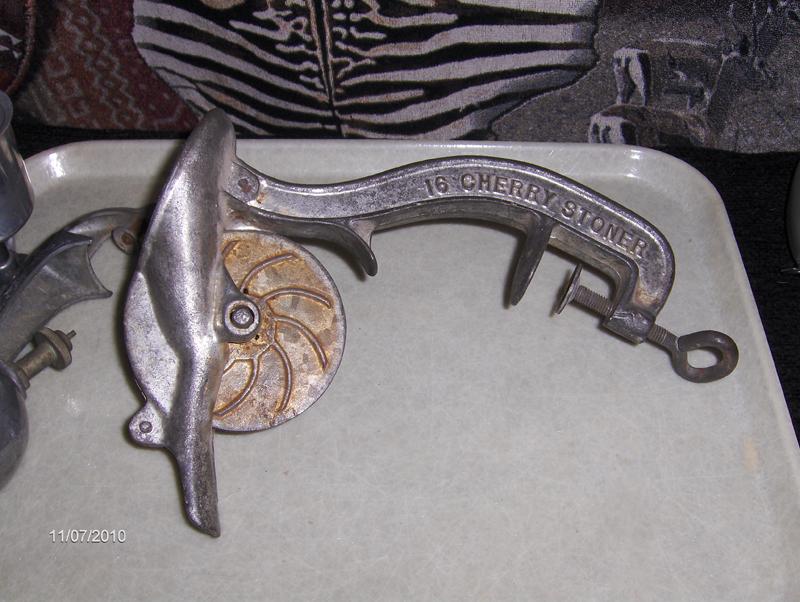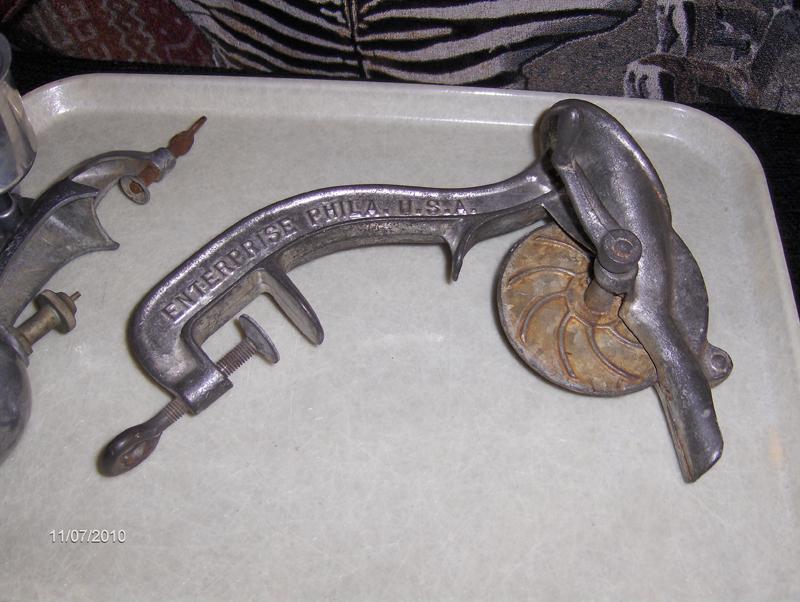-
Posts
11,034 -
Joined
-
Last visited
Content Type
Profiles
Forums
Store
Help Articles
Everything posted by andiesenji
-
In my opinion the best results are with a combination of medium and fine grind (Bob's Red Mill) of the brand found in stores. If you order online from one of the mills that produce heirloom cornmeal, the results of the stone-ground meal, that has not been sifted and divided, you will get essentially a combination of fine, medium and a little coarse. This is easily visible when you look at the meal but you can prove it by simply sifting some through a sieve. (I've actually done this)
-

Yard Sale, Thrift Store, Junk Heap Shopping (Part 2)
andiesenji replied to a topic in Kitchen Consumer
It's beautifully made, obviously an expert potter. Achieving that ribbed effect around the body is difficult and the complexity of the glazes also indicates a great deal of expertise with the process. It was very dirty when I first saw it and I thought it was black. It had been on top of their fridge for a very long time, near the back, and she told me she couldn't remember the last time she washed it and doesn't recall ever using it. She thinks it was a gift from one of her ex-husband's relatives... -
I probably have that one too. It is in one of the boxes of unused "gadgets" I should dispose of but haven't gotten around to it. It worked okay for small cherries but simply would not fit the large ones and the extra large olives I like to stuff for snacks - so I got the combination type. Lehman's used to have a metal cherry stoner but it is no longer in their catalog. Only this one, which is available at Amazon and I believe it was mentioned in an earlier post with a link. Lehman's has gotten a lot of my money over the decades but I am disappointed that they no longer offer some of the real "old-fashioned" kitchen tools that were designed to last for decades. By golly, I found the metal one that Lehman's used to carry. It is more expensive but it does separate MOST of the pits from the cherries.
-
I have several of the hand-held pitters and they are fine for a few cherries or olives, but I can't perform repetitive tasks with either hand so the plunger type is best for me. Here's two. I can use the scissor type a few times but the other one is too stiff for me to use even once - I can only force it through using both hands.
-

Yard Sale, Thrift Store, Junk Heap Shopping (Part 2)
andiesenji replied to a topic in Kitchen Consumer
Found another jug at a yard sale while out walking my dog early Sunday morning. I had no money with me so asked the gal to hold it but she said no sense we walking home and back so sent her son along with me to carry the rather heavy jug. I gave him the money and a bottle of my homemade red wine vinegar for his mum and just got around to washing the jug this morning. It's quite attractive and has an interesting glaze. There are no marks on the bottom. There is a red/brown underglaze and a blue/purple glaze. I don't know if you can see the ribbing detail on the lower body of the jug but it looks like hand-incised ridges - they are not perfectly even so not from a mold. Sorry the one photo is just a tad out of focus. I paid $2.00 for it plus the bottle of vinegar! -
I have this combination cherry pitter and plum stoner (shown with jumbo Ranier cherry) which also works for pitting olives. They also make one that is just a cherry pitter - same style - plastic. It works quite well - better for me than the hand-held one which is difficult for me to use with the arthritis in my hands. I couldn't find it online but there is this one which doesn't have the catch container for the pits but works on the same principle. I have this antique one which I used for many years - it breaks the cherries but does not separate them from the pits so one has to pick over them carefully to make sure you remove every one.
-
Why use oil in pasta water? I never have - and I learned how to cook pasta (and make homemade pasta) from a real Italian grandmother (not mine). Oil in the pasta water does not prevent clumping, it makes the pasta gummy - especially when you are going to use it for cold salads - and it is simply a waste of oil. Dress the pasta with oil after it is cooked. This started back in the 50s or 60s by someone who had the idea that adding oil would keep the water from boiling over the sides of the pot but if you use a pot with ENOUGH ROOM for the water and the pasta, this is not necessary. Have you heard Alton Brown's rant about oil in pasta water?
-
I live in the southern Calif. high desert (above 2000 ft) and have been seriously conserving water for decades - I lived in the San Fernando Valley prior to moving up here and it too would be desert if not for the water projects of the early 20th century. It is still semi-arid. I don't have a grass lawn, I have plants in containers with drip/trickle water systems in the various areas and plants naturally adapted to arid growing conditions, it is not difficult, almost every community - at least in the west - offers classes on xeriscaping for folks who want to conserve water. Many of these plants are slow growing and also require much less maintenance than water-hungry plants that grow rapidly then look trashy if not cared for. My city has been shifting to xeriscaping in "decorative" plantings to conserve water (and no mowing or trimming required) in order to have more water for the places where grass is essential - in parks and playgrounds. Fittings to divert the water from laundry or shower are available for the handy DIY folks but plumbing companies also offer installation and depending on how accessible the drains are, it can take only a little time and therefore is less costly. It is a cinch with the PVC pipes. And one advantage is that many of these plants that evolved in arid or semi-arid conditions PREFER alkaline rather than acid soil - and since soaps and detergents are alkaline, they thrive with this water where plain water actually leaches these materials out of the soil. Desert soils are alkaline - this area is an ancient seabed. When it rains in the summer (rare) and the ground dries out rapidly in the heat, there are white surface deposits that in some areas can look like snow - the alkaline "salts" washed out of the soil and concentrated on the surface.
-
Just mix it well with a whisk before adding the coagulating agent.
-
I have clothespins slip off the bags that are waxy and slippery. I use bindery clips. I have them in all sizes from tiny to huge and they will hold anything securely. I also have some stainless steel alligator clips for really big jobs but they are more expensive.
-
I dry toast them (and other grains) in a cast iron skillet - the one I use for cornbread. It doesn't take long and they have to be constantly stirred - use a wooden spoon. You can see the change in color and can smell the aroma. You can also toast them in the oven but it is a bit trickier because they can get too toasty, too fast and develop a bitterness if you aren't paying attention.
-
I bought the Hamlyn's because I needed another item to get up to the "free shipping" level and re-ordered a couple of times. Then I got a free sample of the Flavahan's and then bought them because I like the taste and the texture. I used them in a recipe for scrapple that specifies pinhead oatmeal and I was quite impressed with the results. I toasted them first.
-
Exactly! I'm not sure when the product changed but when I first began buying them perhaps 25-30 years ago, they had a toasty-malty flavor that was very nice. Prior to that I bought steel-cut oats at a food "co-op" that carried an organic supply in bulk, until the co op was bought by a chain and only sold packaged goods. I tossed out most of the last can of McCann's and even the birds weren't all that thrilled with it. Usually grains disappear rapidly but it took days for the oats to be consumed.
-
McCann's used to have a more pronounced "oaty" flavor. The last tin I purchased, about 2 1/2 years ago, did not have the flavor I expected. I thought perhaps it was my error, possibly not adding enough salt - but then I toasted the next batch and cooked them just as I have been doing for decades and they just did not taste right. I tried Bob's Red Mill (organic Scottish) and they were better than the McCann's I had. I also purchased some Hamlyns pinhead oatmeal (Scotland import) from The British Food Shop online, which was very good. However I like the Flahavan's much better. I've tried a couple of their other products and been pleased with all.
-
Here is the definitive info with photos. I buy Flahavan's Pinhead Oatmeal from Amazon because I cook a lot for porridge both on its own and mixed with other grains. I think the flavor is superior to other brands - like McCann's USED TO BE before they "Americanized" the product. Flahavan's is imported from IRELAND. This may seem like a lot of oats but each bag is "25 servings" but I average 15-20 servings per bag. I also cook this and prepare oat/potato "cakes" cooked on the griddle - the cooked oatmeal mixed half and half with leftover mashed potatoes, fried onions, eggs to bind the mixture and sometimes some sauteed mushrooms. I have this via Subscribe & Save every 6 months. Occasionally I have to request an order a month early - especially in the winter. (I ordered last November and again in April. 10 cents an ounce (with free shipping via Amazon Prime) is cheaper than the bulk pinhead oats at the local market.
-
I rarely use steel cut or pinhead oats in baking - when I do I soak them overnight or if in a hurry, cook them in the rice cooker on the porridge setting. I also sometimes grind them into "flour" using the VitaMix or the Thermomix - a food processor can also be used but it takes a bit more effort. With the latter process you do have to increase the liquid in a recipe because the uncooked oats will take up a lot of moisture. I mix the dry ingredients together, (except for any dried fruits and nuts which might be included) add the liquid, mix well and set aside for at least 30 minutes to hydrate and then add additional liquid, which I have found is always necessary, to get the correct consistency and texture in the batter. For better flavor, I advise toasting the oats prior to soaking, cooking or grinding them.
-
I bought a dozen of the "Stainless Steel spice cans" (not the ones with the clear lids) a few months ago for some of my homemade herb and spice blends - because they stack and unlike some of the metal containers can go in the dishwasher. (Aluminum cans should not go in the dishwasher.) This is a better price than I paid. Some vendors sell individual cans for 5.99 each but I don't think they are the quality of these. I also bought some of the taller cans with clear tops for stick cinnamon, whole cloves and star anise - which I purchase in bulk.
-
I buy raw almonds in bulk - a lot of almonds are grown locally and some of the growers sell them in 5-pound tubs. I steam them - for about 10 minutes, immediately spread them on a thick terry cloth tows and rub to remove the skins while they are still hot. I have an appliance for making almond milk and the directions are to soak the almonds overnight but once they are steamed, I run all the newly blanched ones through the process and freeze the milk. To get a richer, thicker product, I will process more almonds in the previous batch of milk. I've done this to improve the thickness and texture of "yogurt" made with almond milk.
-
I think the difference is that self-rising flour has much less gluten and also less protein so the biscuits will be lighter. Also, that is about twice as much baking powder as I would use. my formula for homemade self-rising flour is for each cup of flour (soft wheat, low gluten or pastry flour) I add 1 1/2 teaspoons of baking powder, and 1/2 teaspoon salt. I never used all-purpose flour for biscuits or scones. If I have none on hand I use 2/3 all-purpose and 1/3 cake flour to "lighten" it but the results are never satisfactory for my taste. Currently I have King Arthur unbleached self-rising flour - 5 lbs, Odlums (Irish) self raising flour - 2 kg, Homepride (British) self raising flour - 1 kg. (the latter was recommended to me by an ex-pat Brit friend. I have been using the Odlums ever since FoodIreland added it about 15 years ago. These are all much better than Gold Medal, Pillsbury or the "new" White Lily. I used to use While Lily but after Smuckers bought the company and moved the milling from the original place, it is just not the same. They claim it is now "improved" but I do not like it at all.
-
I have two of the Dexter Russell sani-safe 12" blade scalloped edge roast slicer - one that I use exclusively for bread and one for cutting cake layers, etc. I bought one of mine at Smart & Final and another at a restaurant supply store. I have tried just about every "bread" knife on the market, and none has worked as well as this for any type of bread. Crusty artisan loaves are no problem and very tender pullman loaves that are to be sliced thinly for tea sandwiches are cut without any tearing of the crumb. Amazon has essentially the exact same knife with the name Winco - cheaper. The local senior center ordered two and as far as I can tell they feel identical in use. Cheap enough that if it doesn't suit, you can toss it or send it back.
-
I allow the dough to hydrate because I am using only heavy cream for both the liquid and the FAT and from long experience I have found that this works better than baking them immediately after mixing. There is none of the business of cutting fat into the dry ingredients - or trying to mix an extremely thick buttermilk/butter mixture which always seems to "seize up" when the melted butter is added to the buttermilk. Everyone has a "favorite" recipe and method and if you try a number of recipes you will find one that works perfectly for you. I always start truly novice bakers out with the self-rising flour and heavy cream biscuit because it is virtually foolproof, even if overmixed a little. I taught this method to a class at the local shelter for abused women and children because some of them had NEVER baked anything from scratch and thought opening a can of refrigerator biscuits was "baking" ... They were so astonished that the mixing went so rapidly and the oven preheated while the dough was "resting" - giving me a chance to explain why. And it is so versatile. I showed them that with the addition of a little sugar and some raisins (or cranberries or even chocolate chips) the "biscuits" could become scones. When I went back the following week, I found they had experimented on their own and the director told me that the cost of the heavy cream (from Smart & Final) was pretty much equal to buying butter and milk or buttermilk, which were part of the alternate recipe suggested by another volunteer.
-
I'm not sure how you could take one statement from an entire page and assume the pepper described were "sweet" when 90% of the text on the page described them as hot and indeed the name of the peppers is "Marbles Hot peppers". The following paragraph immediate precedes the sentence you quoted. " Varying between individual plants, Marbles Hot peppers contain quite a broad range of capsaicin levels. Some offer a mild tease of 300 to 500 Scoville Heat Units - about the same friendly slap you'd get from various types of Tabasco sauce. Other Marbles Hots meanwhile, provide a more full-on punch. The FBI (Fire-Breathing Idiot), or Ted to his friends - the chilli aficionado and famous taster - rates some Marbles Hots (of the Aji Bolivian variety) at 55,000 SHU's. That's around 15 times hotter than a fiery Jalepeño, and is not to be sneezed at. Of course, this is incomparable to the Titans of the chilli world - the 7 Pots, Morugas, Nagas and the like, but not everyone is up for dicing with rocket fuel at dinnertime. Marbles Hots offer a respectable, manageable, pleasant heat. Another Marbles Hots reviewer offered: "They are HOT! I thought they would be milder and bit into one and wasn't expecting the good amount of heat I got"." And the following immediately follows the sentence you quote. " Chilli gurus are happily messing with breeds all the time, to create extra-pretty or (more commonly) extra-hot strains. But as far as I know, at present there are for now 4 varieties of Marbles Hot pepper: the good old standard Marbles Hot, Holiday Marbles Hot, Marbles 5-Colour Hot, and Aji Bolivian Marbles Hot. Marbles Hot peppers are of the taxonomic group Capsicum annuum, and grow ½-inch-wide round chillies. They turn from green to cream or white, then yellow, orange, purple, and then red when mature. The small Marbles Hot pepper plants are adored by gardeners for their beauty. Marbles Hots are all over many farmers' markets and horticultural shows as 'edible ornamentals'. Oregon State University, USA, had a hand in manipulating them to the form they are in now, but they are said to originate from either South America or Mexico. Serious gardening website myfolia.com says from Mexico. Marbles 5-Colour Hots are as Holiday Marbles Hots, but instead of turning green to red, they bring pleasure to the eyeballs by going from white to yellow, to purple, to orange, to red when mature. They can be classed as 'hot', ranging in pungency from 5,000 to 30,000 Scoville Units (thanks Dave's Garden for those figures). "
-
The peppers I described and the ones I grew were NOT SWEET! They are extremely hot. Please check the link I included in my post to this page which describes the heat - which in the ones I grew was MUCH hotter than rocoto or manzano peppers and were also hotter than the Thai hot peppers and the African bird peppers that I grew at the same time. They were comparable to the Scotch Bonnet peppers (that were not as prolific).
-
My favorite in the southern California area is Chado Tea Room - any of the three sites. When I lived in the Valley and the L.A. store was the only one, I used to go about every six weeks or so, both to enjoy talking with the KNOWLEDGEABLE folks who know a lot about tea and the owned had actually visited tea-growing regions in India and Sri Lanka. That store closed some time ago but they opened another in downtown L.A. I've been to the Pasadena store several times since it opened and to the Hollywood store once as it is kind of out of my way. I go to Pasadena to shop at a couple of specialty stores there and Chado is in the area. The food is very good - some people complain about wait times but I have never had the problem but I do not visit the stores at peak times because I also want to spend time selecting teas to bring home.
-
The 5-color marble, aka Chinese 5-color HOT pepper is a prolific producer on fairly small plants that do great in containers. I had one about six years ago, kept it going for two years by bringing it inside for the winter. Extremely hot to moderately hot - depending on growing conditions. If you give them less nutrients and not much water, they will produce a much hotter fruit. Mine had a lot of peppers the same color as in your photo but also yellow to pale orange and a very few that were cherry red with one or two very dark purple, almost black. The paler colors had flesh that was almost translucent - like some of the pale white Hungarian peppers.



